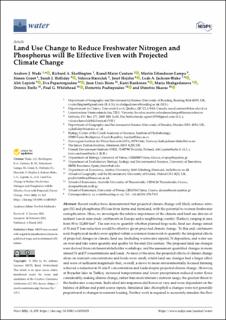| dc.description.abstract | Recent studies have demonstrated that projected climate change will likely enhance nitrogen (N) and phosphorus (P) loss from farms and farmland, with the potential to worsen freshwater eutrophication. Here, we investigate the relative importance of the climate and land use drivers of nutrient loss in nine study catchments in Europe and a neighboring country (Turkey), ranging in area from 50 to 12,000 km2. The aim was to quantify whether planned large-scale, land use change aimed at N and P loss reduction would be effective given projected climate change. To this end, catchment-scale biophysical models were applied within a common framework to quantify the integrated effects of projected changes in climate, land use (including wastewater inputs), N deposition, and water use on river and lake water quantity and quality for the mid-21st century. The proposed land use changes were derived from catchment stakeholder workshops, and the assessment quantified changes in mean annual N and P concentrations and loads. At most of the sites, the projected effects of climate change alone on nutrient concentrations and loads were small, whilst land use changes had a larger effect and were of sufficient magnitude that, overall, a move to more environmentally focused farming achieved a reduction in N and P concentrations and loads despite projected climate change. However, at Beyşehir lake in Turkey, increased temperatures and lower precipitation reduced water flows considerably, making climate change, rather than more intensive nutrient usage, the greatest threat to the freshwater ecosystem. Individual site responses did however vary and were dependent on the balance of diffuse and point source inputs. Simulated lake chlorophyll-a changes were not generally proportional to changes in nutrient loading. Further work is required to accurately simulate the flow and water quality extremes and determine how reductions in freshwater N and P translate into an aquatic ecosystem response. | en_US |

